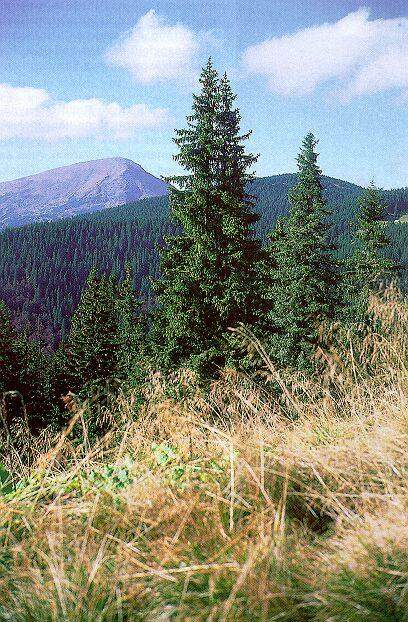CHORNOHIRSKYI PROTECTED MASSIF |
||
|
THE MAIN DIRECTIONS OF ACTIVITY CHORNOHIRSKYI PROTECTED MASSIF UHOLSKO - SHYROKOLUZHANSKYI PROTECTED MASSIF PROTECTED MASSIF "VALLEY OF NARCISSI" BOTANICAL PRESERVE “CHORNA HORA” /BLACK MOUNTAIN/ BOTANICAL PRESERVE “YULIVSKA HORA” /YULIVSKA MOUNTAIN/ LANDSCAPE REGIONAL PARK "STUZHYTSIA"
|
The main range of Chornohora is formed by flysch rocks (argillites, aleurolites, sandstones, gritstones etc.) of cretaceous and paleogenic age. The modern geomorphological structure of Chornohora is dated by miocene-holocenic periods. The upland relief has traces of the ancient ice formation with the typical glacial forms - cirques and trough valleys. The climate of Chornohirskyi massif is moderately continental: from cool humid up to cold euhumid. While altitude is higher, the air temperature reduces, and the amount of precipitation increases. According to the data of Luhy meteostation (613 m.a.s.l.), the average temperature of the coldest month (January) is 6.8 degrees below zero, warmest (July) - 15.7 degrees, the average annual temperature - 5.4 degrees. The average annual amount of precipitation is 1001 mm. According to the data of Pozhyzhevska meteostation (1430 m.a.s.l.), the average temperature of January is 6.4 degrees below zero, July - 11.5 degrees, the average annual temperature - 2.8 degrees. The annual amount of precipitation increases up to 1465 mm. Large amount of precipitation causes availability of the well-advanced hydronet. The main headwaters of the White Tysa river are located in the massif’s territory. Typical for the forest formations are light-brown and dark-brown mountain-forest soils. In the upland areas prevail peat-mountain-podzolic and mountain-meadow-brown soils. The Chornohirskyi protected massif is characterized by the large diversity of vegetation and flora. The prevailing type of vegetation is forest. The pure beech forests are rarely found in the territory of Chornohora, where the climate is cool, and they are timed to the southern slopes. The mixed larch-conifer forests with Fagus sylvatica, Abies alba, Picea exceisa, which grow up to 1200 m height, are found in a wider altitudinal range. The zonal fir-groves of the climax character are found higher, forming the upper forest line, which lies here at an altitude of 1500 - 1600 m. The climax communities of elfin woodland (Mugheta, Duschekieta and Junipereta) are spread in the subalpine zone. The grassy communities of Deschampsia caespitosa, Calamagrostis villosa are found here in considerable areas. Smaller areas are occupied by Nardus stricta. The alpine meadows are formed by the communities of Carex sempervirens, Festuca supina and Juncus trifidus. The communities with the prevailing Carex curvula and Lerchenfeldia flexuosa are found fragmentary. Flora of the Chornohirskyi massif is characterized by a number of rare species, such as: Atragene alpina, Helleborus purpurascens, Leucanthemum waldschteinii, Listera cordata, Rhododendron kotschyi, Aconitum firmum, Anemonastrum narcissiflorum, Chrysosplenium alpinum, Gentiana acaulis, G. verna, Melampyrum saxosum, Parageum montanum, Pedicularis verticillata, Polygonum viviparum, Pulmonaria fillarskiana, Rhodiola rosea etc. The nucleus (characteristic combination of species) of the Chornohirskyi massif’s vertebrate fauna is formed by the species of taiga and alpine complexes. In upland areas, at an altitude of about 1800 m, one can found a snow vole (Chyonomis nivalis) and alpine accentor (Prunella collaris), entered into the Red Data Book of Ukraine. The typical species of conifer and mixed forests in Chornohora are: three-toed woodpecker (Picoidus tridactylus), goldcrest (Regulus regulus), ring ouzel (Turdus torquatus), black grouse (Lyrurus urogalus) lynx (Lynx lynx), bear (Ursus arctos) etc. In general, fauna of the Chornohirskiy massif is represented by species, typical for the whole forest zone of the Carpathians. A lot of evertebrate species of the Carpathian and Eastern Carpathian endemics, which are registered in the Ukrainian Carpathians, are found only in Chornohora: Calosoma inquisitor, Carabus trassylvanicus, Trechus picatulus, Duvalius ruthenus (Carabidae, Coleoptera). |
 It is located on the
southern macroslope of the Chornohirskyi range, at an altitude of 700 - 2061 m.a.s.l. The
highest peak of the Ukrainian Carpathians - Hoverla Mountain (2061 m) is located in the
massif’s territory, the total area of which is 16375 ha.
It is located on the
southern macroslope of the Chornohirskyi range, at an altitude of 700 - 2061 m.a.s.l. The
highest peak of the Ukrainian Carpathians - Hoverla Mountain (2061 m) is located in the
massif’s territory, the total area of which is 16375 ha.